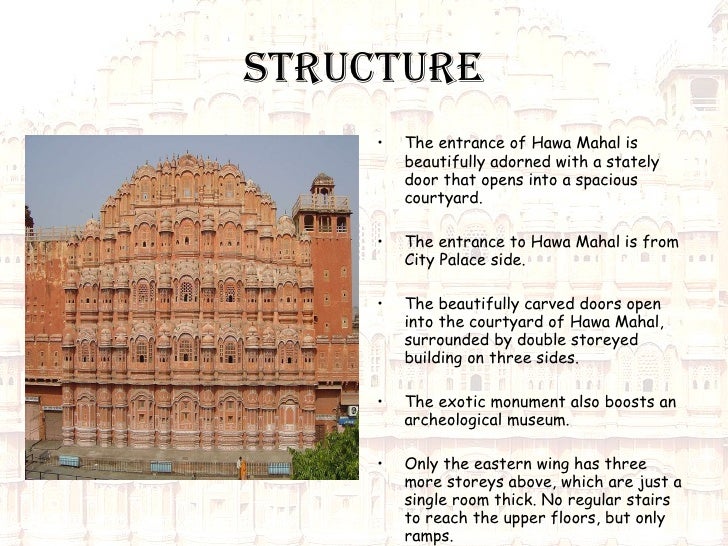Courtesy:http://www.jaipur-travel-guide.com/Jaipur-attractions/Hawa-Mahal-Jaipur-Palace-Winds.html

Hawa Mahal Jaipur, palace of Winds
The Hawa Mahal Jaipur is the beautiful many windowed extension of the City Palace that is said to resemble the honeycomb structure of a bee’s nest. Since the construction of the Hawa Mahal Jaipur in 1799 the building has become the iconic structure of the city and the pink sandstone palace is considered as the finest example of Rajput architecture.

The Hawa Mahal, Palace of Winds
The Hawa Mahal Jaipur translated into English means the Palace of the Winds and this name is in reference to the clever cooling system which propagates a gentle breezes through the inner rooms even during the intense Rajasthan summers. This ingenious design has been completely lost after a recent renovation in which windows were installed behind each of the lattice openings, so today the palace of winds has no wind.
Hawa Mahal Jaipur Features
The Hawa Mahal Jaipur acts as an optical illusion from the street level, here it appears as a massive structure but in actual fact the building is just an elaborate facade which is only an inconsequential part of the City Palace. The Hawa Mahal Jaipur covers 5 floors and this pyramidal structure signifies both the crown of the Hindu god Krishna and the the tail of a peacock implying royalty and power.
The palace was constructed from pink sandstone but in 1876 the exterior walls were painted with a calcium oxide paint that gives Jaipur its distinct pink colour. The palace was designed in 1799 by architect Lalchand Usta under the guidance of Maharaja Sawai Pratap Singh Marah as an extension of the zenana (woman’s chambers) part of the maharaja’s harem of the City Palace. The building's original function was to allow women to observe the daily life of the city whilst staying unseen from the street and commoner level.
The small lattice windows were angled to over look the city's main market and central boulevard. Along this boulevard royal processions or religious ceremonies would pass within sight of the women hidden behind the beautiful lattice windows. In later years the rooms of the Palace of the Wind found favour with the Royal family of Jaipur, as the rooms were always considerably cooler than the main bulk of the City Palace due to the constant air flow through the windows.

The Hawa Mahal, Palace of Winds
This forced separation of the maharaja’s many wives and concubines from the outside world is called purdah and the origins of the word mean curtain. The Hawa Mahal did not contain curtains but intricate marble grills that covered each of the small windows on the balconies called jharokhas. The stunning lattice work is best appreciated from inside the palace where it is possible to view close at hand the skilled craftsmanship of the builders.
Hawa Mahal Jaipur Tourist Information
The Hawa Mahal is best viewed from outside the City Palace’s walls on the chaotic Badi Chaupad cross roads. It is from these streets that poor city folk have looked up, wondered and marveled at the lavish and simple unimaginable life styles that were lived meters from their extreme poverty.
History

It was in 1799 that the Kachhwaha Rajput ruler,
Sawai Pratap Singh, grandson of Maharaja Sawai Jai Singh who built Jaipur,
constructed Hawa Mahal as a continuation of the Royal City Palace. Sawai Pratap
Singh's devotion to Lord Krishna is evident in the palace's construction as it
resembles the lord's crown. Though many reasons are cited behind the
construction of the fort, Purdah system followed by the Rajputs is said to be
one of the main causes. During those days, Rajput royal women did not appear in
public or in front of strangers. However, they were keen to follow the
day-to-day events and royal processions occurring on the streets. It is for
their benefit that the Hawa Mahal was built, complete with small windows and
screened balconies. This gave the women a sense of freedom, without appearing
in public.
Architecture

Hawa Mahal, designed as a beehive castle with
small windows, has a height of 50 feet from its base. This structure, erected
on a thin shield or podium approximately fifty feet high, has walls less than a
foot thick. Constructed of red and pink sandstones by Lal Chand Ustad, Hawa
Mahal is famous for its windows or 'Jharokhas' which enable free circulation of
air within the structure. Its entrance is a door which leads to a spacious
courtyard surrounded by two-storey buildings on three sides. Of the five storeys
of the Mahal, the top three storeys have the thickness of a single room while
the bottom storeys have courtyards. The interior of the Hawa Mahal is stark and
plain with passages and pillars reaching to the top storey. The building does
not have stairs to reach the upper floors; the storeys are connected by slopes.
From Hawa Mahal, you have an excellent view of the city. The monument also has
an archeological museum.
Nearby Tourist Attractions
There are numerous attractions around Hawa Mahal
such as the famed Jantar Mantar, Govind Devji temple, Amer Fort, Nahargarh
Fort, Ram Niwas Bagh, BM Birla Planetarium, Jain Temple, Statue Circle, Sisodia
Rani Garden and so on.
Hawa Mahal, which is the quintessence of Rajput
architecture, stands high in the heart of Jaipur city as a prominent
attraction. Hope this article familiarizes you with Hawa Mahal and its historic
significance.
Courtesy:http://www.jaipur-travel-guide.com/Jaipur-attractions/Hawa-Mahal-Jaipur-Palace-Winds.html
0 comments:
Post a Comment